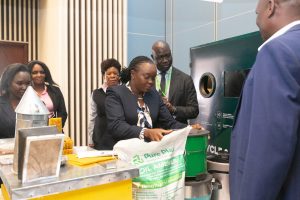Kitchen Gardens as a Lifeline in Kenya’s Drylands

By Winnie Osulah, Lead for Gender Integration at AGRA, and Bertha Lilian Mkandawire, Lead
for Nutrition-Sensitive Agriculture at AGRA
The most powerful solutions to complex challenges are often those that are localized, sustainable, and
empowering. Nowhere is this clearer than in Kenya’s Arid and Semi-Arid Lands (ASALs), which stand as a
persistent battleground against hunger and malnutrition.
Amidst this struggle, a quiet revolution is underway, marking a transformative chapter for farmers in
counties like Kitui, Tharaka Nithi, Embu, and Makueni: the adoption of regenerative agriculture and its
central feature, the kitchen garden.
Kitchen gardens are proving to be more than just a farming practice; they are a lifeline, providing
sustenance and concurrently restoring the health and fertility of the soil. The kitchen gardens are also
advancing women’s empowerment, not only supplying women with the resources needed to cultivate
their own food but also delivering measurable economic advantages that foster financial independence
and decrease household susceptibility to poverty.
Under the Strengthening Regenerative Agriculture in Kenya (STRAK) project, regenerative agriculture is
actively providing nutritious food for families, enhancing social roles and self-confidence among women
farmers, and challenging traditional gender roles, elevating women’s status – both within their
households and communities. Kitchen gardens are vital grounds where vegetables, fruits, and herbs
flourish for domestic consumption. They serve as crucial sources of daily sustenance, promoting nutrition
within families, which is essential for health and vitality.
However, the benefit extends beyond nourishment; these gardens act as important economic cushions.
By supplying fresh produce directly at the homestead, they reduce the family’s reliance on having to
purchase vegetables at inflated prices from distant markets.
This success is mirrored in farmers like Lucia, a farmer and Village-Based Advisor (VBA), who has become
a picture of success. Using regenerative practices in her kitchen garden, Lucia cultivates a diverse array of
crops, including kale, onions, pumpkins, coriander, spinach, and pawpaw, ensuring her family is well-fed
with a balanced diet rich in essential nutrients.
In regions grappling intensely with water scarcity—the defining characteristic of the ASALs—regenerative
agriculture assumes a critical role in ensuring sustainable agricultural productivity. The beauty of these
practices is that they transcend conventional farming methods by prioritizing holistic and ecologically
mindful techniques.
Kitchen gardens built upon the foundation of RA are fundamentally designed for resilience. The
techniques employed—such as the use of organic fertilizers, water conservation techniques, mulching,
intercropping, and crop rotation—are actively restoring soil health and, crucially, mitigating the impact of
drought. By building healthy soil, these gardens emerge not only as champions of nutrition and hunger
alleviation but also as contributors to climate change mitigation.
The integration of kitchen gardens in regenerative agriculture assures rural populations’ nutritional
security and livelihood resilience. This approach offers a sustainable solution to malnutrition while
fostering resilience in the face of climatic challenges. Advocating for every homestead to embrace a
kitchen garden is a direct way to ensure a local supply of nourishment, combat hunger, and significantly
reduce dependence on external relief food.
To ensure that this quiet revolution is sustainable and scalable, it requires coordinated action.
Governmental bodies, non-governmental organizations, and other stakeholders must play their part.
By providing incentives, training, and resources, these stakeholders can empower farmers to better
comprehend and implement regenerative agriculture in both their kitchen gardens and their larger fields.
It is high time we recognize and cultivate the regenerative power of kitchen gardens, envisioning a future
where this innovative farming practice successfully nurtures both the land and its people across Kenya’s
drylands.




